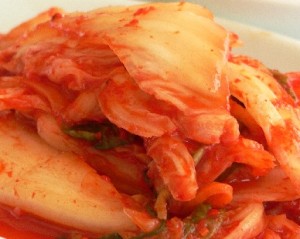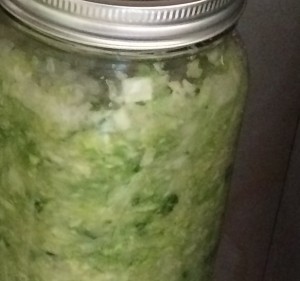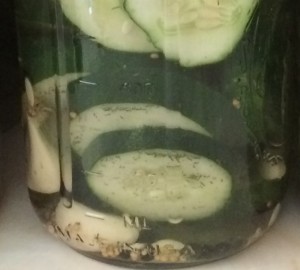 Homemade Eggnog
Homemade Eggnog
4 cups whole raw milk
6 raw pastured eggs
¼ cup grade B maple syrup or raw honey (I don’t like it sweet so I don’t use much)
¼ teaspoon vanilla extract
Cinnamon, clove and nutmeg spices to your liking (I just shake them in until it tastes right)
Mix in blender for 3 minutes or longer to really get it creamy
(Add alcohol if you choose)
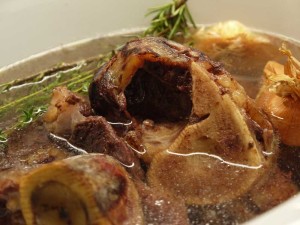 Grass-Fed Beef Broth
Grass-Fed Beef Broth
Broth or “stock” plays an important role as its easily digestible, helps heal the lining of your gut, and contains valuable nutrients.
“Stock contains minerals in a form the body can absorb easily—not just calcium but also magnesium, phosphorus, silicon, sulfur and trace minerals. It contains the broken down material from cartilage and tendons–stuff like chondroitin sulphates and glucosamine, now sold as expensive supplements for arthritis and joint pain.” – Sally Fallon
Recipe from: Nourishing Traditions by Sally Fallon
Equipment:
- Chef’s Knife
- Fine strainer
- Stockpot or Crock Pot / Slow Cooker
- Quart size mason jars
- roasting pan
Ingredients:
- 4 pounds of beef marrow, knuckle bones, bits of leftover beef
- 3 pounds meaty rib or neck bones
- 4 or more quarts cold water
- 1/4 cup vinegar
- 3 onions, coarsely chopped
- 3 carrots coarsely chopped
- 3 celery sticks, coarsely chopped
- Celtic sea salt – optional – only after broth is completed
Preparation:
- Place all of your bones that have meaty bits on them on a roasting pan and brown in the oven at 350 degrees until well-browned (30-60 minutes usually).
- Meanwhile, throw all of your non-meaty marrow bones into a stockpot, add the water, vinegar and vegetables. Let sit while the other bones are browning.
- Add the browned bones to the pot, deglaze your roasting pan with hot water and get up all of the brown bits, pour this liquid into the pot. Add additional water if needed to cover the bones.
- Bring to a boil and remove the scum/foam that rises to the top. No need to remove the floating fat. Reduce heat, cover and simmer for at least 12 hours and as long as 72 hours. The longer you cook the stock, the more rich and flavorful it will be.
- After a 2-3 hours you will want to ‘rescue’ any of the meat you need for recipes or marrow that you’d like to eat. Using tongs find your marrow bones, pop out the marrow with a small knife and return the bone to the pot.
- After you simmer for 12-72 hours, remove the bones with a slotted spoon and/or tongs. Strain the stock into a large bowl, then ladle into wide mouth mason jars.
- Let the jars sit until they are pretty cool, then freeze or refrigerate. You can remove the congealed fat after refrigerating or even freezing, if you want to reduce it a step.
Please note the addition of vinegar is essential because when it comes to making broth, the vinegar helps leech all the valuable minerals from the bones into the stockpot water, which is ultimately what you’ll be eating. The goal is to extract as many minerals as possible out of the bones into the broth water.
Variation: this same technique can be used to prepare lamb or venison stock.
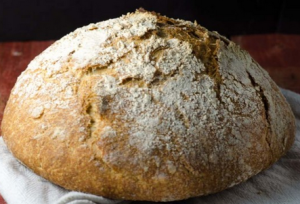 Whole grain, No-Knead Sourdough Bread
Whole grain, No-Knead Sourdough Bread
Recipe from: the Nourished Kitchen by Jennifer McGruther
“As a result of the work of wild bacteria and yeasts that give sourdough its characteristic flavor, sourdough breads are lower on the glycemic index, higher in bioavailable minerals, and higher in B vitamins than quick-rise breads. And they taste better, too.” – Jennifer McGruther
Prep Time: 6 hours, 5 minutes
Cook Time: 45 minutes
Total Time: 6 hours, 50 minutes
Yield: 1 loaf
Ingredients
- 2 cups high-extraction einkorn flour
- 1 1/2 cups whole-grain einkorn flour, preferably freshly ground
- 1/4 cup proofed and bubbly sourdough starter
- 1 1/2 cups room temperature water
- 2 teaspoons finely ground unrefined sea salt
- olive oil, for oiling the bowl
Instructions
- Put the flours, sourdough starter, water and salt into the basin of a standmixer equipped with a dough hook. Mix the ingredients together on medium-low speed until they form a uniform ball of dough that cleans the sides of the mixing bowl, about three minutes.
- Oil a 4-quart glass mixing bowl and place the ball of dough into the mixing bowl. Cover tightly, and let it rise in a warm spot in your kitchen for six to eight hours, or until doubled in bulk.
- Place a 6-quart cast iron or enameled cast iron Dutch oven in a cold oven, and then heat the oven to 450 F.
- Flour your working surface, and put the dough onto the floured surface, gently forming it into a boule. Cover it with the empty glass mixing bowl, and allow it to rise for 30 minutes.
- Remove the bowl, and if the dough has spread, reform it. Working quickly, open the oven and remove the lid from the preheated Dutch oven. Put the dough into the Dutch oven, cover once more, and bake, covered, for 30 minutes. Remove the lid to the Dutch oven, and continue baking a further 15 minutes until the bread is fragrant and a light amber brown.
- Remove the bread from the oven and allow it to cool on a wire rack before slicing and serving.
Notes
You can substitute bread flour or all-purpose flour for high-extraction flour. If you do not have einkorn flour, substitute spelt or wheat.
 Sweet Potato and Poblano Pepper Soup
Sweet Potato and Poblano Pepper Soup
Recipe from: the Nourished Kitchen by Jennifer McGruther
The poblano is a mild chili pepper originating in the state of Puebla, Mexico. Dried, it is called ancho or ancho chile, from the Mexican Spanish name ancho or chile ancho.
Ingredients
- 1 tablespoon extra-virgin coconut oil
- 1 shallot, peeled and finely minced
- 2 poblano peppers, seeded and sliced thin
- 2 medium sweet potatoes or garnet yams (peeled and cubed)
- 1/4 teaspoon ground cumin
- 1 teaspoon smoked paprika
- 1 tablespoon unrefined sea salt
- 2 quarts Roast Chicken Stock
- Sour Cream, to serve
- Minced Red Onion, to serve
- Minced Cilantro, to serve
Instructions
- Melt the coconut oil in a heavy-bottomed stock pot over medium heat. Stir in the shallot, and fry gently until it softens and releases its fragrance. Stir in the poblano pepper, and fry until softened – about 4 minutes.
- Add the sweet potatoes to the pot along with cumin, smoked paprika and sea salt. Cover the pot and sweat the potatoes until they soften – about 10 minutes. Pour in the chicken stock, and simmer, covered, for 30 minutes or until the potatoes fall apart when pierced with a fork. Turn off the heat, and puree the soup with a blender, until the soup is smooth and uniform.
- Ladle into soup bowls, and serve topped with sour cream, red onion and cilantro as you like it.
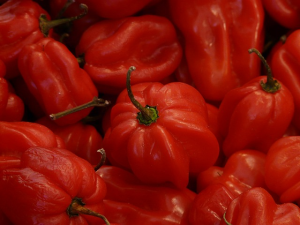 Fermented Hot Chili Sauce
Fermented Hot Chili Sauce
“To prepare a good fermented hot chili sauce, you need just three simple ingredients: chilies, salt and time…” ~ Jenifer McGruther
Recipe by Jennifer McGruther, author of:
The Nourished Kitchen, Farm-to-Table recipes for the Traditional Foods Lifestyle
Yield: about a quart
Prep Time: 20-25 mins
Ferment Time: 5 to 7 days
Ingredients
3 pounds fresh chili peppers (Scotch bonnets, Jalapenos, Serranos etc.)
4 to 6 cloves garlic, peeled and minced
2 tablespoons unrefined cane sugar, optional
2 teaspoons unrefined sea salt
1/4 cup fresh whey
Instructions
- Snip the stems from the chilies, but leave their green tops intact.
- Combine all ingredients in a food processor, or mince by hand, until chopped to a fine pasty texture.
- Spoon the chili paste into a glass mason jar and allow it to fermented, covered, at room temperature for five to seven days.
- After the chili paste has bubbled and brewed for about a week, set a fine-mesh sieve over a mixing bowl and spoon the fermented chili paste into the sieve. With a wooden spoon, press the chili paste into the sides of the sieve so that the sauce drips from the sieve into the waiting mixing bowl.
- Once you’ve pressed and pushed the chili sauce through the sieve, pour the sauce from the bowl into jar or bottle and store in the refrigerator. The sauce will keep for several months.
“Seasoned with fresh garlic this fermented hot chili sauce is rich with flavor, bright and fiery. Use it in strict moderation to add flavor and heat to your meals. You’ll notice that the flavor of this sauce is more uniquely complex than vinegary sauces you can purchase at the grocery store.” ~ Jennifer McGruther
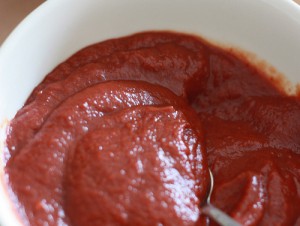 Lacto-fermented Ketchup
Lacto-fermented Ketchup
Time to let go of the sugar laden, chemical filled tomato sauce!
Another delicious recipe from:
Sally Fallon’s Nourishing Traditions
Ingredients
- 3 cups canned tomato paste
- ¼ cup whey
- 1 tbls sea salt
- ½ cup maple syrup
- ¼ tsp cayenne pepper (optional)
- 1 clove garlic, peeled and mashed
- ½ cup fish sauce
Instructions
- Mix all ingredients until well blended.
- Place in a quart sized, wide mouth Mason jar.
- Leave at least 1 inch below the top of the jar.
- Leave at room temperature for about 2 days before transferring to cool storage or refrigerator.
If you keep the ketchup a long time and forms mold on top simply scrape it away. If it acquires a fermented, fizzy, sour flavor, discard and make a new batch.
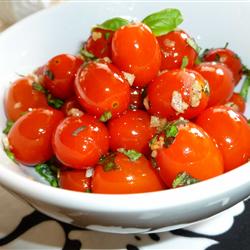 Cherry-Tomatoes and Basil
Cherry-Tomatoes and Basil
This has been my go-to since the garden is up and going!
Fresh cherry tomatoes, and basil are a classic combination, but sometimes the dish can be very plain. Here, whole cherry-tomatoes are mixed with fresh basil, salt and pepper, and then tossed with olive oil and tangy apple cider vinegar. Nothing plain about this.
Ingredients
- 2 cups cherry tomatoes
- 2 T chopped basil
- 1 large cucumber (chopped or sliced to your liking)
- Olive Oil (drizzle to taste)
- Apple cider vinegar (drizzle to taste)
- salt and pepper (to taste)
Instructions
- Toss together the cherry tomatoes, chopped basil and the cucumber with a bit of salt & pepper.
- Drizzle olive oil on top (however much you want), along with a drizzle of apple cider vinegar and toss again till blended well.
Serve with any meal and enjoy!
Lacto-fermented Kimchi
Great with almost any meal! Like all fermented foods, kimchi is extraordinarily rich in beneficial bacteria – those bacteria that line the gut and help to build our immune system, manufacture and assimilate vitamins. Kimchi, and other fermented foods, may also play a role in the alleviation of risks for metabolic syndrome. Notes This recipe is from: Nourishing Traditions by Sally Fallon. Ingredients
- 1/4 lb ginger (peeled and cut into chunks)
- 1/4 lb fresh chili peppers (trimmed of stems, seeded if desired)
- 2 tbsps whole, unrefined cane sugar (find it here)
- 2 tbsps fish sauce (find chemical-free fish sauce here)
- 1/4 cup unrefined sea salt (divided)
- 2 large heads Napa cabbage (chopped into large chunks about 2 inches by 2 inches)
- 1 1/2 lbs carrots (scraped and cut into finger-length sticks 1/4-inch thick)
- 1 1/2 lbs daikon radish (scraped and cut into finger-length strips 1/4-inch thick)
- 8 heads garlic (peeled and chopped)
Directions
- Place ginger, chili peppers, sugar, fish sauce and 1 tbsp sea salt into a food processor. Process until you form a smooth paste.
- Place chopped cabbage into a large mixing bowl, sprinkle with remaining sea salt and cover with warm (not hot) water. Stir until sea salt dissolves and allow the cabbage to sit for twenty to thirty minutes. Drain the cabbage and pat it dry.
- Place the cabbage, carrots, radish and garlic in a large mixing bowl. Spoon in the chili and ginger paste you prepared in step #1 and toss to coat.
- Transfer the mixture, cup by cup, into a gallon-sized vegetable fermenter or fermentation crock (available here) and pound down with a wooden spoon until the vegetables release their juice. Continue layering and pounding until all the vegetables have been transferred to the crock. Pound again until the vegetables have released all their juice and the level of brine fully covers the vegetables and that the vegetables rest within one inch of the crock’s lip.
- Weight the vegetables down with your crock’s weight or a small sterilized stone, cover and ferment at room temperature for at least one week before trying the kimchi. If you prefer a sourer flavor, ferment longer.
Transfer to the refrigerator when the kimchi has reached the desired level of sourness where it will keep for at least six months.
Fermented Sauerkraut
We love fermented foods! Traditional fermented foods like sauerkraut are usually bursting with beneficial lactic acid bacteria that boost digestive health. Homemade sauerkraut is positively a better choice to improve your digestive health.
Notes
This recipe is from: Nourishing Traditions by Sally Fallon.
Ingredients
- 2 medium cabbage heads (cored and finely shredded)
- 2 tablespoons sea salt
Equipment
Glass jars with lids, quart size
Directions
- Toss cabbage and salt together in a large mixing bowl and begin to squeeze the cabbage and salt together with your hands, kneading it thoroughly to break up the cellular structure of the shredded cabbage.
- When the cabbage has become limp and releases its juice, transfer it to your glass jars. Pack the salted cabbage into each jar as tightly as you can, eliminating air bubbles.
- Continue packing the cabbage into the container until the cabbage is completely submerged by liquid. Cover loosely and allow it to sit at room temperature, undisturbed, for at least 1 month and up to 6 months, testing the sauerkraut every few days until it is done to your liking.
Transfer to the refrigerator or other cold storage where it should keep for at least 6 months and up to 1 year.
Lacto-Fermented Dill Pickles
We love pickles!
Lacto-fermented pickles are tremendously healthy and actually probiotic, it’s better to make pickles when cucumbers are in season. Modern pickles are canned with vinegar, which doesn’t do much good for your digestive system. Lacto-fermented pickles, on the other hand, are similar to eating yogurt or drinking kefir. Add pickles to your meals to get a probiotic boost!
Notes
This recipe is from: Nourishing Traditions by Sally Fallon.
Ingredients
- Cucumbers, organic if possible, pickling (4-5) or gherkins (15-20)
- Mustard seeds (1 TBS)
- Dill, fresh (2 TBS)
- Sea salt (2 TBS) — where to buy sea salt
- Filtered water (1 cup)
- Optional: Oak or grape leaf (1) (helps to make the pickles crisp and crunchy.)
Equipment
Glass jar with lid, quart size
Directions
- Wash cucumbers well and place in a quart-sized wide mouth jar.
- Rinse an oak or grape leaf and add it to the jar.
- Combine the mustard seeds, dill, sea salt and filtered water together.
- Pour over the cucumbers, adding more water if necessary to cover the cucumbers. (The top of the liquid should be at least 1 inch below the top of the jar.)
- Cover tightly and keep at room temperature from 3-7 days before transferring to the refrigerator.
Depending on the size of the cucumbers, it may take up to one week to fully sour.

